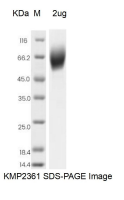Human CD33L3 Protein, His Tag
-
产品编号
KMP2361
-
别名
唾液酸结合免疫球蛋白样凝集素-15, Sialic acid-binding Ig-like lectin 15, Siglec-15
-
规格
- 50ug
- 100ug
- 200ug
| Alias | 唾液酸结合免疫球蛋白样凝集素-15, Sialic acid-binding Ig-like lectin 15, Siglec-15 |
| Catalog Number | KMP2361 |
| Product Description | The Human CD33L3 Protein(KMP2361) is produced in HEK293 Cells and the target gene encoding Phe20-Thr263 is expressed with a 6His tag at the C-terminus. |
| Molecular Name | CD33L3 |
| Species | Human |
| Host | HEK293 Cells |
| Size | 50ug, 100ug, 200ug |
| Purity | >95% as determined by SDS-PAGE |
| Purification | Affinity purification |
| Endotoxin | <1.0 EU/ug determined by the LAL method |
| Formulation | PBS, 150mM Nacl, 0.3% Chaps, 5% Trehalose, pH7.4 |
| Background | Human Siglec-15 is a transmembrane glycoprotein in the Siglec family. Siglecs are type I transmembrane proteins where the NH3+-terminus is in the extracellular space and the COO--terminus is cytosolic. Each Siglec contains an N-terminal V-type immunoglobulin domain(Ig domain) which acts as the binding receptor for sialic acid. These lectins are placed into the group of I-type lectins because the lectin domain is an immunoglobulin fold. All Siglecs are extended from the cell surface by C2-type Ig domains which have no binding activity. Siglecs differ in the number of these C2-type domains. Human Siglec-15 consists of a 244 amino acid(aa) extracellular domain(ECD) with two Ig-like domains, a 21 aa transmembrane segment, and a 44 aa cytoplasmic domain. Siglec-15 function is important for osteoclast formation and TRANCE/RANK Ligand signaling in osteoclasts |
| SDS-PAGE |  |
| Predicted Molecular Weight | 27.39 kDa |
| Storage Condition | Aliquot and store at -20℃ to -80℃. Avoid repeated freezing and thawing cycles. |
| Shipping Condition | In general, the proteins are provided as lyophilized powder which are shipped at ambient temperature. They are shipped out in dry ice if supplied in liquid form. |
| Uniprot ID | Q9BZZ2 |
| References | 1.Mol. Microbiol. 49:1213-1225 (2003) 2.Cell Res. 25:1121-1136 (2015) 3.PLoS Pathog. 13:e1006181-e1006181 (2017) 4.J. Extracell. Vesicles 10:e12046-e12046 (2021) 5.Cell. Mol. Immunol. 18:2676-2678 (2021) 6.Nat. Microbiol. 4:1558-1570 (2019) |
| Function | Macrophage-restricted adhesion molecule that mediates sialic-acid dependent binding to lymphocytes, including granulocytes, monocytes, natural killer cells, B-cells and CD8 T-cells. Plays a crucial role in limiting bacterial dissemination by engaging sialylated bacteria to promote effective phagocytosis and antigen presentation for the adaptive immune response (PubMed:12940982, PubMed:33489013). Mediates the uptake of various enveloped viruses via sialic acid recognition and subsequently induces the formation of intracellular compartments filled with virions (VCCs)(PubMed:28129379). In turn, enhances macrophage-to-T-cell transmission of several viruses including HIV-1 or SARS-CoV-2 (PubMed:28129379, PubMed:34782760). Acts as an endocytic receptor mediating clathrin dependent endocytosis. Preferentially binds to alpha-2,3-linked sialic acid (PubMed:12940982). Binds to SPN/CD43 on T-cells (By similarity). May play a role in hemopoiesis. Plays a role in the inhibition of antiviral innate immune by promoting TBK1 degradation via TYROBP and TRIM27-mediated ubiquitination (PubMed:26358190). (Microbial infection) Facilitates viral cytoplasmic entry into activated dendritic cells via recognition of sialylated gangliosides pesent on viral membrane. |





 0
0
